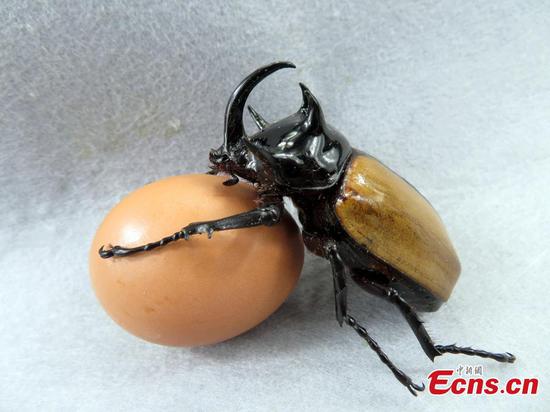The giant salamander's distress call resembles the cry of a baby. Threatened by extinction, the creature probably doesn't know it should sound an alarm.
A study has for the first time revealed that there are at least five subspecies of the giant salamander in China. Old conservation studies knew of one, which could have hastened the process of extinction of the rest, Chinese animal experts said on Monday.
Experts at the Kunming Institute of Zoology under the Chinese Academy of Science (CAS), recently published an article - "The Chinese Giant Salamander Exemplifies the Hidden Extinction of Cryptic Species" in the Current Biology, an international academic journal, disclosing that their decade-long genome study on the giant salamander in China has found at least five subspecies, rejecting the traditional view that there is only one species of the animal.
These subspecies have been named after their habitats - Shaanxi, Sichuan, Guangxi, Guizhou and Anhui, and the overwhelming majority in Chinese farms is Shaanxi. The number of breeds could be up to eight, which is yet to be confirmed.
Giant panda in the water
The Kunming institute said in a statement sent to the Global Times on Monday that the animal, dubbed the "giant panda in the water" and whose origin could date back to the Jurassic Realm, used to be widely distributed around the country's 17 provinces, in the waters of the Yangtze River, the Yellow River and the Pearl River areas, before it started to die due to habitat loss and excessive capture since the 1950s.
The amphibian, better known as "wawayu" or "babyfish" in Chinese for its distress call resembles the cry of a baby, is currently enlisted as a second-class protected animal species in China and categorized as "critically endangered" on the International Union for Conservation of Nature (IUCN) Red List.
China has established 48 natural reserves since 1982 to save the aquatic animal, covering about 17,100 hectares. After mastering artificial breeding, the country has released 105,918 farmed giant salamanders back into nature, the statement said.
However, as the price of a sexually mature wild babyfish could cross 10,000 yuan ($1,558), illegal fishing of the wild population since the mid-1990s has almost killed them all, despite thousands of such creatures being bred in farms, the statement said.
Apart from illegal fishing, climate change has also added to the stakes of the animal's survival, as the amphibians are particularly susceptible to it, Li Ying, senior officer with the Climate and Energy Practice Department of WWF-Beijing, told the Global Times on Monday.
A survey jointly conducted by the WWF and the CAS' Chengdu Institute of Biology shows that one third of the endangered aquatic creature had disappeared in 2016, whereas over 47 percent of the 104 surveyed amphibian species in China are highly vulnerable to climate change, with the giant salamander coming close to functional extinction, according to Li.
Affected by climate change and illegal fishing, the population of the giant salamander had dropped by more than 80 percent in the period between 1950s and 2000, and the survivors face the menace of gene drift and inbreeding depression, Li said.
Identity crisis
China has been undertaking widespread release of farmed animals as a conservation measure, which, according to Li, helps to some extent.
Li suggested that to curb illegal fishing of the wild population, all artificially farmed giant salamanders should be identified before they are released on the market.
"Now that we have found five subspecies, it is urgent to change our old preservation strategy to preserve biodiversity," Zhao Tian, an employee with the Chengdu Institute of Biology, told the Global Times. If we continue to follow the old pattern, Zhao explained, it is very likely to accelerate the extinction of the other subspecies.
Releasing the Shaanxi breed to a different subspecies' habitat would do more harm than good, as it could damage gene purity as well as habitat conditions, Zhao said.
Although the giant salamander is listed as a protected species in China, consumption of the second filial population that has been artificially bred is permitted. However, the classification is confusing to average consumers, Zhao said.
This makes it hard to monitor what is going on in the market, allowing loopholes for poachers, Zhao added, while suggesting a nationwide field survey to locate different wild subspecies and gather habitat information.


















































